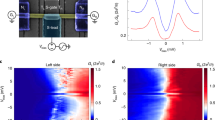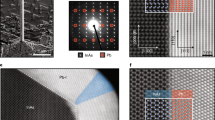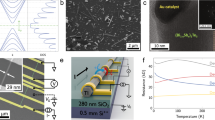Abstract
Semiconductor nanowires are ideal for realizing various low-dimensional quantum devices. In particular, topological phases of matter hosting non-Abelian quasiparticles (such as anyons) can emerge when a semiconductor nanowire with strong spin–orbit coupling is brought into contact with a superconductor1,2. To exploit the potential of non-Abelian anyons—which are key elements of topological quantum computing—fully, they need to be exchanged in a well-controlled braiding operation3,4,5,6,7,8. Essential hardware for braiding is a network of crystalline nanowires coupled to superconducting islands. Here we demonstrate a technique for generic bottom-up synthesis of complex quantum devices with a special focus on nanowire networks with a predefined number of superconducting islands. Structural analysis confirms the high crystalline quality of the nanowire junctions, as well as an epitaxial superconductor–semiconductor interface. Quantum transport measurements of nanowire ‘hashtags’ reveal Aharonov–Bohm and weak-antilocalization effects, indicating a phase-coherent system with strong spin–orbit coupling. In addition, a proximity-induced hard superconducting gap (with vanishing sub-gap conductance) is demonstrated in these hybrid superconductor–semiconductor nanowires, highlighting the successful materials development necessary for a first braiding experiment. Our approach opens up new avenues for the realization of epitaxial three-dimensional quantum architectures which have the potential to become key components of various quantum devices.
This is a preview of subscription content, access via your institution
Access options
Access Nature and 54 other Nature Portfolio journals
Get Nature+, our best-value online-access subscription
$29.99 / 30 days
cancel any time
Subscribe to this journal
Receive 51 print issues and online access
$199.00 per year
only $3.90 per issue
Buy this article
- Purchase on Springer Link
- Instant access to full article PDF
Prices may be subject to local taxes which are calculated during checkout




Similar content being viewed by others
Change history
22 November 2021
Editor’s Note: The authors have alerted the editors of Nature to potential problems in the manner in which some of the raw data in this paper have been processed. While Nature is investigating the impact this will have on the conclusions of the paper, readers are cautioned against using results reported therein.
19 April 2022
A Correction to this paper has been published: https://doi.org/10.1038/s41586-022-04704-2
References
Lutchyn, R. M. et al. Majorana fermions and a topological phase transition in semiconductor–superconductor heterostructures. Phys. Rev. Lett. 105, 077001 (2010)
Oreg, Y. et al. Helical liquids and Majorana bound states in quantum wires. Phys. Rev. Lett. 105, 177002 (2010)
Alicea, J. et al. Non-Abelian statistics and topological quantum information processing in 1D wire networks. Nat. Phys. 7, 412–417 (2011)
Hyart, T. et al. Flux-controlled quantum computation with Majorana fermions. Phys. Rev. B 88, 035121 (2013)
Aasen, D. et al. Milestones toward Majorana-based quantum computing. Phys. Rev. X 6, 031016 (2016)
Plugge, S. et al. Majorana box qubits. New J. Phys. 19, 012001 (2017)
Vijay, S. & Fu, L. Teleportation-based quantum information processing with Majorana zero modes. Phys. Rev. B 94, 235446 (2016)
Karzig, T. et al. Scalable designs for quasiparticle-poisoning-protected topological quantum computation with Majorana zero modes. Phys. Rev. B 95, 235305 (2017)
van Weperen, I. et al. Spin-orbit interaction in InSb nanowires. Phys. Rev. B 91, 201413 (2015)
Kammhuber, J. et al. Conductance quantization at zero magnetic field in InSb nanowires. Nano Lett. 16, 3482–3486 (2016)
Zhang, H. et al. Ballistic Majorana nanowire devices. Preprint at https://arxiv.org/abs/1603.04069 (2016)
Fadaly, E. M. T. et al. Observation of conductance quantization in InSb nanowire networks. Nano Lett. http://dx.doi.org/10.1021/acs.nanolett.7b00797 (2017)
Mourik, V. et al. Signatures of Majorana fermions in hybrid superconductor-semiconductor nanowire devices. Science 336, 1003–1007 (2012)
Deng, M. T. et al. Majorana bound state in a coupled quantum-dot hybrid-nanowire system. Science 354, 1557–1562 (2016)
Albrecht, S. M. et al. Exponential protection of zero modes in Majorana islands. Nature 531, 206–209 (2016)
Shabani, J. et al. Two-dimensional epitaxial superconductor-semiconductor heterostructures: A platform for topological superconducting networks. Phys. Rev. B 93, 155402 (2016)
Conesa-Boj, S. et al. Gold-free ternary III-V antimonide nanowire arrays on silicon: twin-free down to the first bilayer. Nano Lett. 14, 326–332 (2014)
Plissard, S. R. et al. From InSb nanowires to nanocubes: looking for the sweet spot. Nano Lett. 12, 1794–1798 (2012)
Caroff, P. et al. InSb heterostructure nanowires: MOVPE growth under extreme lattice mismatch. Nanotechnology 20, 495606 (2009)
Dalacu, D. et al. Droplet dynamics in controlled InAs nanowire interconnections. Nano Lett. 13, 2676–2681 (2013)
Kang, J.-H. et al. Crystal structure and transport in merged InAs nanowires MBE grown on (001) InAs. Nano Lett. 13, 5190–5196 (2013)
Rieger, T. et al. Crystal phase transformation in self-assembled InAs nanowire junctions on patterned Si substrates. Nano Lett. 16, 1933–1941 (2016)
Car, D. et al. Rationally designed single-crystalline nanowire networks. Adv. Mater. 26, 4875–4879 (2014)
Krogstrup, P. et al. Epitaxy of semiconductor–superconductor nanowires. Nat. Mater. 14, 400–406 (2015)
Gül, Ö. et al. Hard superconducting gap in InSb nanowires. Nano Lett. 17, 2690–2696 (2017)
Gül, Ö. et al. Towards high mobility InSb nanowire devices. Nanotechnology 26, 215202 (2015)
Hansen, A. E. et al. Mesoscopic decoherence in Aharonov–Bohm rings. Phys. Rev. B 64, 045327 (2001)
Beenakker, C. W. J. Quantum transport in semiconductor–superconductor microjunctions. Phys. Rev. B 46, 12841 (1992)
Adachi, S. & Kawaguchi, H. Chemical etching characteristics of (001) InP. J. Electrochem. Soc. 128, 1342–1349 (1981)
Dalacu, D. et al. Selective-area vapour–liquid–solid growth of InP nanowires. Nanotechnology 20, 395602 (2009)
Webb, J. L. et al. Electrical and surface properties of InAs/InSb nanowires cleaned by atomic hydrogen. Nano Lett. 15, 4865–4875 (2015)
Meijer, F. E. et al. Statistical significance of the fine structure in the frequency spectrum of Aharonov–Bohm conductance oscillations. Phys. Rev. B 69, 035308 (2004)
White, L. K. Bilayer taper etching of field oxides and passivation layers. J. Electrochem. Soc. 127, 2687–2693 (1980)
Acknowledgements
We acknowledge N. Wilson for the assistance at University of California, Santa Barbara. This work has been supported by the European Research Council (ERC HELENA 617256 and Synergy), the Dutch Organization for Scientific Research (NWO-VICI 700.10.441), the Foundation for Fundamental Research on Matter (FOM) and Microsoft Corporation Station-Q. We acknowledge Solliance, a solar energy R&D initiative of ECN, TNO, Holst, TU/e, imec and Forschungszentrum Jülich, and the Dutch province of Noord-Brabant for funding the TEM facility. We thank the Office of Naval Research (ONR) for financial support. The work at University of California, Santa Barbara was supported in part by Microsoft Research. We also acknowledge the use of facilities within the National Science Foundation Materials Research and Science and Engineering Center (DMR 11–21053) at the University of California, Santa Barbara and the LeRoy Eyring Center for Solid State Science at Arizona State University.
Author information
Authors and Affiliations
Contributions
S.G., D.C., J.A.L., C.J.P. and E.P.A.M.B. carried out the material synthesis. H.Z. and M.W.A.M. fabricated the devices and performed the transport measurements and data analysis. S.C.B., M.C.C. and R.S. carried out the substrate preparation. D.X. and G.W. fabricated the hard-gap devices and contributed to the measurement. S.G. and R.L.M.O.H.V. did the nanowire manipulation for the TEM analysis and transport measurements. M.A.V. performed TEM analysis. B.S., D.P. and J.S.L. contributed to the experiments at University of California, Santa Barbara. S.K. prepared the lamellae for TEM analysis. J.S. and D.B. contributed to the hard-gap device fabrication. K.Z. and Y.V. contributed to the Aharonov–Bohm device fabrication and data analysis. P.J.V.V. supported work with the MOVPE reactor. E.P.A.M.B., C.J.P. and P.K. provided key suggestions on the experiments. E.P.A.M.B., C.J.P. and L.P.K. supervised the projects. All authors contributed to the writing of the manuscript.
Corresponding author
Ethics declarations
Competing interests
The authors declare no competing financial interests.
Additional information
Reviewer Information Nature thanks J. Alicea and the other anonymous reviewer(s) for their contribution to the peer review of this work.
Publisher's note: Springer Nature remains neutral with regard to jurisdictional claims in published maps and institutional affiliations.
Extended data figures and tables
Extended Data Figure 1 Fabrication of InP substrate with trenches.
1–8: Schematic illustration of the processing steps. 1, An out of the box wafer is etched in 7:1 buffered HF; an oxygen plasma step is performed to create a ‘sacrificial’ native oxide layer of 1.9 ± 0.1 nm (ref. 33); a 20 nm SiOx hard mask is deposited followed by another oxygen plasma treatment. 2, 3, 4, The electron-beam primer and resist layer is spun; rectangular windows of ~200 nm are written using EBL and subsequently developed. 5, 6, The hard mask is etched using reactive ion etching (RIE) with CHF3 and Ar. 7, 8, The wet etch in HCl (37%):H3PO4 (85%) with 5:1 ratio is performed to expose (111)B facets in InP (100) and the hard mask is removed using 7:1 buffered HF. A detailed fabrication recipe can be found in Methods.
Extended Data Figure 2 Catalyst deposition.
1–8: Schematic illustration of the processing steps. 1, 20 nm SixNy mask is deposited followed by an oxygen plasma treatment. 2–4, E-beam primer and resist layer is spun (nominal resist thickness needs to be half of the depth of the trenches); arrays of dots (10–50 nm) are written on inclined (111)B facets using e-beam lithography and the resist is then developed. 5, Openings in SixNy mask are defined using short 20:1 buffered HF etch. 6–8, 10 nm of gold is evaporated through the opening in SixNy mask followed by a lift-off. A detailed fabrication recipe can be found in Methods.
Extended Data Figure 3 Role of the SixNy mask in InSb nanowire growth.
a, b, A 30°-tilted SEM image of InP–InSb nanowires grown on a substrate without (a) and with (b) SixNy mask. A substantial amount of parasitic thin film growth is observed in a. Concave edges of the trenches act as a preferential nucleation site for InSb growth. Thin-film InSb growth is in direct competition with InSb nanowire growth, resulting in short nanowires and a very low yield of crossed junctions. By covering the substrate with a SixNy mask, the growth is restricted to areas where the InP substrate is exposed30. This, in combination with approximately 100 times lower molar fractions of TMIn and TMSb used for the growth of wires shown in b, eliminates the unwanted InSb layer growth and allows for growth of high-aspect-ratio InSb nanowires which merge into networks. Both scale bars are 1 μm.
Extended Data Figure 4 Lithographic control over the trench design layout enables growth of hashtags spanning different loop areas.
a, b, InSb nanowire networks grown on trenches with different spacing between the left–left (L1, L2) and right–right (R1, R2) trenches, labelled a and b in Fig. 1a, respectively. Control over the dimensions of the trenches allows us to tune the length of the hashtag parallelogram. The scale bars are 1 μm.
Extended Data Figure 5 Structural analysis of a hashtag taken from the substrate and deposited on a holey carbon film using a micromanipulator in the SEM.
a, High-angle annular dark field (HAADF) scanning TEM image of the hashtag. The red arrows indicate the positions of the gold catalyst particles. For one wire, the InP stem is present and recognizable. b, Corresponding bright field (BF) TEM image. c, BFTEM image displaying the central part of the hashtag as well as the 1.3 μm aperture inserted for the selected area electron diffraction (SAED) pattern displayed in d. The pattern represents a superposition of three twin-related 〈110〉 zone axis patterns. e, To reveal the orientation of the individual wires of the hashtag, SAED patterns for all the wires were acquired, using a smaller SAED aperture diameter of 0.25 μm. Three different 〈110〉 zone axis patterns were recorded. The colour coding of the apertures in e corresponds to the SAED patterns in f–h. i, Schematic representation of the formation of the hashtag presented in the TEM images. The blue and purple nanowires have two different orientations, related by a 180° rotation around their long axis. Thus, one of the wires has the same orientation as the substrate wafer, while the other one is twin related. The two yellow wires have identical orientations that differ from the orientations of the two other wires. Thus, these yellow wires are also twin-related to the substrate, though their rotation axis is different from that of the blue and purple wires.
Extended Data Figure 6 The number of superconducting islands, n + 1, is determined by the number of wires, n, directly in front of the shadowed nanowire.
a, A high-magnification top-down SEM image of the region indicated by a red rectangle in b. The three nanowires facing the Al flux cast shadows on the wire directly behind them, resulting in InSb nanowires with four superconducting islands. The shadowing offset is about 200 nm. The nanowires bend towards each other owing to the e-beam exposure during imaging.
Extended Data Figure 7 Aharonov–Bohm oscillations in four devices with different hashtag surface areas.
Device A has been studied in detail in the main text. For all devices, left upper panel shows the pseudo-coloured SEM image of the device, middle panels show the conductance measured in the out-of-plane (top) and in-plane (bottom) magnetic field and right panel shows the ensemble averaged FFT spectrum. Only the out-of-plane magnetic field, whose flux penetrates through the hashtag loop, gives Aharonov–Bohm oscillations which indicates that the Aharonov–Bohm oscillations indeed originate from the coherent interference of electron waves of the two separated conducting nanowire arms. A magnified view of the Aharonov–Bohm oscillations (a zoom-in on the region indicated by an orange rectangle in the upper middle panel) is shown in the lower left panel, while the right panel shows the averaged FFT spectrum. Plot of the peak frequency, assigned from the averaged FFT spectra, as a function of the measured loop area of the four devices is shown in the inset of Fig. 3b. Weak-antilocalization peak at B = 0 T is present for both field directions, and in three (A, B, D) out of four devices, suggesting the strong spin–orbit nature of the InSb nanowire network. The corresponding back gate voltages of the four devices are: 15 V, 9 V, 12 V and 9 V, respectively. Temperature is 300 mK. The scale bar is 1 μm.
Extended Data Figure 8 Ballistic transport, Andreev enhancement and hard gap in additional Al-InSb devices.
a, Above-gap (normal carriers) conductance of device Y as a function of Vgate. A conductance plateau near the quantized value (2e2/h) can clearly be seen, indicating ballistic transport. b, dI/dV versus bias voltage in the open and tunnelling regime, resolving strong Andreev enhancement (green) and a hard gap (red), respectively, with Vgate indicated by arrows in panel a. The coherence peaks are smeared out owing to thermal broadening (temperature of about 300 mK for this device). The Andreev enhancement is due to Andreev reflection: an incoming electron reflects as a hole at the N–S interface generating a Cooper pair. This process effectively doubles the transported charge from e to 2e, enhancing the sub-gap conductance. Our enhancement factor reaches 1.7 × 2e2/h, indicating the high Al–InSb interface transparency, with transmission larger than 0.96. The small dip in Andreev enhancement near zero bias is due to mode mixing induced by minimal residual disorder11. c, Sub-gap versus above-gap conductance of device Y (black dots), and a theoretical fit (red) based on the Beenakker formula, showing perfect agreement over three orders of magnitude conductance change. d, dI/dV of device Z as a function of Vgate. e, A line cut from panel d (black bar), plotted in linear (top) and logarithmic scale (bottom). The above-gap/sub-gap ratio is larger than 300. f, dI/dV of device M as a function of Vgate. g, A line cut from panel f (black bar), plotted on linear (left) and logarithmic scale (right). h, Sub-gap versus above-gap conductance of device M (black dots), and the Beenakker theoretical fit (red). Device shown in the main text (X), and devices Z and M are measured at around 20 mK.
About this article
Cite this article
Gazibegovic, S., Car, D., Zhang, H. et al. RETRACTED ARTICLE: Epitaxy of advanced nanowire quantum devices. Nature 548, 434–438 (2017). https://doi.org/10.1038/nature23468
Received:
Accepted:
Published:
Issue Date:
DOI: https://doi.org/10.1038/nature23468
This article is cited by
-
Van der Waals nanomesh electronics on arbitrary surfaces
Nature Communications (2023)
-
Roadmap of the iron-based superconductor Majorana platform
Science China Physics, Mechanics & Astronomy (2023)
-
Sub-nanometer mapping of strain-induced band structure variations in planar nanowire core-shell heterostructures
Nature Communications (2022)
-
Retraction Note: Epitaxy of advanced nanowire quantum devices
Nature (2022)
-
Thermodynamics Controlled Sharp Transformation from InP to GaP Nanowires via Introducing Trace Amount of Gallium
Nanoscale Research Letters (2021)
Comments
By submitting a comment you agree to abide by our Terms and Community Guidelines. If you find something abusive or that does not comply with our terms or guidelines please flag it as inappropriate.



